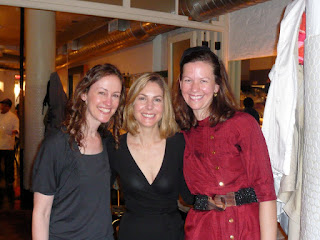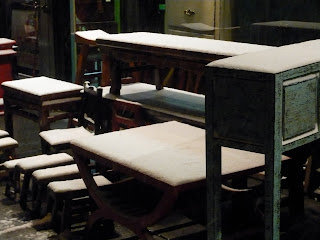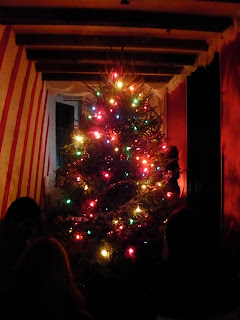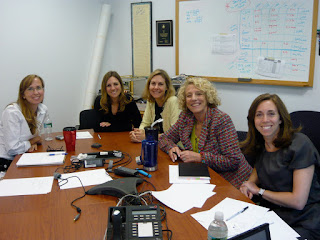I was returning to the New York skyline after nearly three months, and nearly 10,000 miles of driving.
For weeks on end, I have been passing prairie land and tunnels, rolling farm hills, shockingly large midwestern skylines. But I hadn't been here since September, but also not since before the adventure of the tour. Any adventure changes you, in whatever small way. An adventure has the character of an art project, a process that changes the outcome.
I have returned to New York on this particular day for a wedding, and it bears mention whose it is, because the book tour started and ended with this one. There are not many people for whom I would host a bridal shower the day before my book came out, but Amee is one of them. Her other best friend -- also named Amy -- was in from Paris for one weekend and one weekend only, in September, and it was the one my book came out.
So the day before the Brooklyn Book Festival (the afternoon before my mom, Greg, and I raised champagne glasses in the St. Francis school lunchroom), I helped host a shower. I lugged a group-gift espresso maker from the Upper East Side here, at Bread on the Lower East Side:
(It's nice to co-host a shower with someone who is a food writer. With a dessert specialty.)
Here is the mother of the bride, taking the house down with her toast:
I don't have any pictures of the wedding. I am still too old-fashioned (and have too small an evening handbag) to carry a camera to a wedding. It was at the Yale Club, portraits of Bill Clinton and both George Bushes looking on from the back of the room. You felt like if we hit that part of the liturgy where they ask for support of the marriage and everyone says, "We will" that we might get some barritone back-up from behind us.
It was Christmastime in New York. There was so much to look at.
And I was seeing it still with travelers' eyes. There was the dog on my street
There was the office holiday party, atmospheric and very fun:
There were things I didn't have time to catch on camera, like a car with a huge silver menorah mounted to the roof, as if narrow set, perfectly symmetrical reindeer antlers. There was the neighborhood bakery, tiny and steamed up and full to the brim with loaves of bread so large they wouldn't fit on most tables in Manhattan.
There was the Mud coffee truck, with its yellow flowers:
And Christmas tree markets, that smell of pine needles, like the breath of fabric softener walking past a laundromat:
Arriving back, I got keys to the apartment, and my sweet sister met me with a dress for the wedding, and time for a coffee at Mud proper on East 9th Street. We visited with Monique, the Polish facialist and proprietor of Monique K (East Village gem), who is as much life lesson herself as enforcer of respect for the skin. She was moving back to Poland in retirement to spend time with her sister and to volunteer in an orphanage where she is qualified to teach ballet, languages, music, and a few other things, but where she is most interested in helping children also to know that they are loved.) In her appealing way, she explained that my having written a book meant my family should walk around "with their noses to the sky." This is a bit of a before (or after driving) picture for me, though Monique always looks beautiful. My sister and I have known her for years, and this was one of the last times we would see her before her departure.
It was a beautiful wedding, one of those where the groom beams and the bride walks in and everyone looks for a tissue, in the nicest possible way. I admittedly limped through a little bit of the hits of the eighties at the end. It was snowing in New York.
It snowed again the next week, covering the tables outside shops,
causing clerks to hit awnings with broom handles to beat out accumulating drifts, leaving the city in that gauzy half-light of falling snow.
Meanwhile, Museum Legs starting turning up on a couple of New and Noteworthy tables, totally without my doing. At the Museum of Modern Art:
At the 86th Street Barnes and Noble:
I spoke at the Art and Beauty reading group at McNally Jackson, a favorite independent, where a man named Eddie and I had a spirited back and forth about whether, as he thought, there should be an economic charge for most everything, museums included, because the changing hands of money represented the flow of energy in the world. (I tried to joke about whether he should be paying me for the reading group.)
And I was a guest at my sister's book group, a charming and interesting collection of people who quipped that my presence meant they would actually have to talk about the book:
(You'll note from the table and background that it is a culinary club as well.)
I went to Jane's MoMA leaving party:
I went to Dave's Eggnog Party--in the peak of the snowstorm.
A group called Grand Opening has a space on Norfolk Street (between Rivington and Stanton). They convert the space into different things. Before it had been a Vegas-style wedding chapel. At the holidays, it was a tree trimming and eggnog party space that you could book in two-hour increments.
Next, it is slated to be a Trade School where people teach things on a barter economy. I am on deck to teach Business School for Artists. I haven't yet decided what barter request I will make of my students, but I am hoping it will involve Twitter-blog-Facebook-web tutorials, snacks, and vegetarian recipes. And maybe some good music recommendations too, and some trawling through listings of bands' live shows.
I appreciated that their ornaments still had K-mart price tags
and their paper garlands looked like cut-up Excel charts. I talked for a while with Ben, one of two Canadian brothers who run a design firm out of the back and who collaborate with artist friends who run an artist-to-artist barter website. The entire team had had a holiday party the night before and he claimed to be the worse for wear.
And work is good. I love to write but I also love having colleagues. Everyone needs a workplace where you learn the little things. Rory: "The subway has a schedule." Even if it doesn't stick to schedule, you can know whether it's on a four minute or eight minute interval, to arb the difference between stations.
My mother arrived in town and my nuclear family ended up gathering for sushi takeout at mine, since I was living in take-out range of a favorite sushi restaurant downtown (that I have always called "Tah-mo-ee" but have just learned is "To-mo"). In honor of my sister's firm, here is the sign in their window:
Christmas took us to Fairfield where the main event was, in this picture, sitting in my sister's lap:
Nephew Jack. He usually looks a lot happier without the hat, and actually has a pretty winning smile.
The day before Christmas, the woman whose place I was staying in left me a voicemail. The day after Christmas we finally spoke, and I learned that her landlord wanted me to vacate immediately, with threat to her lease. So, in an uncomfortably biblical turn, I looked to friends and family back-up as I packed my bags against what was to be several days of creative projects rabbit hole. A crack team of Taylor-Arnaizes in Houston arranged for me to stay in her brother's room in Brooklyn, while they sent me keys to their own place too. Sweet, sweet other people offered back-up plans, called doormen, proffered kindness. My brother repeated his standing "twenty minutes" advance MetroNorth-warning open-door policy. My mother invited me to join her at a Philadelphia conference. Mental note to self to get a permanent home soon.
I finally got all my things loaded into a cab to go to Brooklyn, full sets of papers for two books in progress. Having been in dealer mode, it wasn't until I got into the cab that I felt the floor fall out and wanted to cry, and then I arrived in Brooklyn to find the roommate of my friend's brother making vegetarian dinner for his two younger sisters who were all warm and hilarious. So, all ended well -- in a household of musicians where you can count about eight keyboard devices in the living room, where the dinner menu is an appealing tour of great grains of great empires (farro, quinoa. . . ), and where maybe anther book project will yet take shape.
The writer Dave Hickey, who lives in Las Vegas, once described the relief of returning to his home city after time on the road. Traveling as an art critic, he felt like, in his words, an aging gigolo asked to conjure responses to increasingly abject works of modern art. Thus, it was a relief to return to one of the only, again in his words, indigenous landscapes on the North American continent. A place where there was everything to see and nothing asking to be looked at.
Returning almost anywhere after travel feels a bit like that last part. In my case, seeing visual thinking everywhere (e.g., a barber shop where you can point to the wall):
It has never felt so good to have both feet planted on the ground. But I am looking forward to book tour visitors to New York. And I'll be in a plane again in February if not before. Please look me up in New York in 2010, and in London in early Feb.
In the meantime, thanks for reading this. I imagine reading a blog is a bit like having a conversation about this trip, but I am looking forward to pulling up to the other side of that table myself. Cyberspace does, after all, have its limitations. As to Cyberspaces's advantages, I consider this blog a book of sketches. They will get edited and sorted. And I will add some pictures I have been given, in particular by my kind colleague David Haber, of the book launch party.
And as to the far dimensions of a blog, as a form, I am not someone who thinks "private life" is an oxymoron. If your story appears at all in these pages and, for whatever reason, you would rather that it didn't, just let me know and I will make edits, and amends. With that, I hope to see you soon.
p.s. The bride of this post, and of the tour bookends, was also the host of the very first Museum Legs event, a pre-tour "What Would Leonardo Do?" brown-bag lunch at her place of employment, a very large US corporation headquartered in the New York area. The talk was about creativity in everyday life, which in professional life is finding prosperity in the broad sense and in personal life is finding one's life's work. Here are the pictures:


































































































